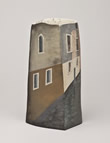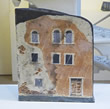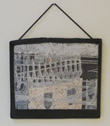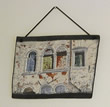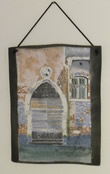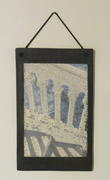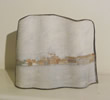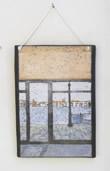ELIZABETH RAEBURN
Views of Venice
17 November - 20 December 2010
 Elizabeth Raeburn’s views, vessels and plaques of
Venice are magical creations. Like the city itself, she
takes ordinary materials and transforms them into
something unique. Admittedly the city is sometimes
dealing in rather extraordinary materials, marble and
mosaic, but the fundamental experience of Venice
is based on clay (bricks) timber (piles) and water.
Elizabeth’s work is about this remarkable creation
and fundamentally uses the same materials and in
using them she has achieved a liquid intensity which
evokes Venice and its many light effects in a way that
I have never seen before despite years of interested viewing both in London and Venice.
Elizabeth Raeburn’s views, vessels and plaques of
Venice are magical creations. Like the city itself, she
takes ordinary materials and transforms them into
something unique. Admittedly the city is sometimes
dealing in rather extraordinary materials, marble and
mosaic, but the fundamental experience of Venice
is based on clay (bricks) timber (piles) and water.
Elizabeth’s work is about this remarkable creation
and fundamentally uses the same materials and in
using them she has achieved a liquid intensity which
evokes Venice and its many light effects in a way that
I have never seen before despite years of interested viewing both in London and Venice.
The city challenges every artist. It is, surely, the starting point for the Scylla of more bad art and banal views than any other place and then there is the Charybdis of the great renderings from Canaletto to Turner and Monet. How do you successfully steer between them and come through the straits with your own, quality, achievement?
These works, like good watercolours, seem deceptively effortless, which could not be achieved without a refined sensibility and wonderful technical mastery of the raku process. The result is that this body of work offers us a number of pleasures. There is the subtle evocation of the different lights and times of day and the fascinating interplay of sea and sky with the changing bands of the man-made stringing across the horizon, from campaniles and domes to the light transformed silhouette of Mestre and Marghera. When she turns her attention to the smaller scale one marvels at the technical brilliance, and the appropriateness of its use, in the sun flashing from the wet stones of a bridge approached through a sottoportego. Those qualities are also to be found, backed by the delicate abstraction of paving patterns, in a small dish with two seagulls.
But there is another level of delight to be explored, the relationship between the image, surface, and the form of the clay. One feels that this is informed by her deep love of the material, its undulations reflecting its original malleable, liquid state acting as a metaphor for the irregular and undulating state of the city. Whether what has been made is a plaque or a vessel, the image and the clay are in harmony and to understand this harmony more thoroughly means that one must understand more of the raku process itself, and for this I want to use Elizabeth’s own words:
"Raku as a technique can be highly sophisticated or used very freely. I prefer ‘informed freedom’. The pieces are taken out of the kiln with tongs while the glaze is in melt, and placed in sawdust or another combustible material, depending on the final effect required. Even in well-controlled circumstances, the firing of ceramics is unpredictable. Raku uses this unpredictability: the firing can be as creative as the making and the surprise element adds a new dimension. I design and work slowly and carefully; the immediacy of the firing and the need to make quick decisions are in direct contrast. It is this balance, which for me brings the work to life."
This clear description of the process gives an insight into the subtle mastery of Elizabeth’s work. The balance of the various elements of the art of raku serves beautifully to conjure up the delicate balance of elements that is Venice.
William Wilkins
Artist, Chairman of Artes Mundi
Trustee of the Derek Williams Trust
Photograph: Anita Besson & Elizabeth Raeburn in Venice during Carnival, 2010.





